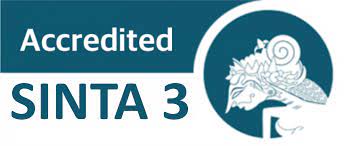ENGAGING STUDENTS IN 15-MINUTE SILENT READING IN ENGLISH CLASS: STUDENTS’ PERCEIVED BENEFITS
Abstract
Grounded from the input hypothesis proposed by Krashen in language learning, a plethora of studies has been addressed to investigate the role of extensive reading which is generally done as an outside classroom activity. However, the integration of similar activities as a part of teaching procedures in the classroom is inadequately explored. Therefore, to fill this lacuna, this article briefly chronicles the enactment of 15-minute silent reading as the adoption of extensive reading in an English class. 32 freshmen were recruited on a voluntary basis. Nested in action research, students engaged in five activities: 1) building knowledge and tutorial,2) material self-selection, 3) silent reading, 4) short sharing session, and 5) individual and collective reflection within 5 weeks of time frame. Findings from the classroom observations, students’ reflective journals, and oral collective reflection indicate that the participants responded positively and acknowledged some valuable benefits. Overall, the empirical evidence suggests that 15-minute silent reading can be one of alternative activities to be integrated in the classroom instruction.
Keywords
Full Text:
PDFReferences
Aka, N. (2020). Incidental learning of a grammatical feature from reading by Japanese learners of English as a foreign language. System, 91, 1-14.
Beglar, D., Hunt, A., & Kite, Y. (2012). The effect of pleasure reading on Japanese university EFL learners' reading rates. Language Learning, 62, 665e703.
Bell, T. (2001). Extensive reading: speed and comprehension. The Reading Matrix, 1(1), 1-13.
Braun, V., & Clarke, V. (2006). Using thematic analysis in psychology. Qualitative Research in Psychology, 3(2), 77–101.
Bryman, A. (2008). Social research methods. Oxford: Oxford University Press.
Chang, C. S., & Renandya, W. A. (2017). Current practice of extensive reading in Asia: Teachers’ perceptions. The Reading Matrix, 17(1), 40-58.
Clark, C., and K. Rumbold. (2006). Reading for Pleasure: A Research Overview. London: National Literacy Trust.
Cremin, T., M. Mottram, F. M. Collins, S. Powell, and K. Safford. (2014). Building Communities of Engaged Readers: Reading for Pleasure. London: Routledge.
Cullinan. B. (2000). Independent reading and school achievement. Research Journal of the American Association of School Librarian, 3, 1-24. Accessed November 13, 2020 http://www.ala.org/aasl/pubs/slr/vol3
Day, R. & Bamford, J. (2002). Top Ten Principles for Teaching Extensive Reading. Reading in a Foreign Language, 14(2), 136-141.
Day, R. R., & Bamford, J. (1998). Extensive reading in the second language classroom. Cambridge: Cambridge University Press.
Guthrie, J. T. & Wigfield, A. (Eds.). (1997). Reading engagement: Motivating readers through integrated instruction. Newark, DE: International Reading Association.
Guthrie, J. T., & Wigfield, A. (2000). Engagement and motivation in reading. In M. L. Kamil, P. B. Mosenthal, P. D. Pearson, & R. Barr (Eds.), Handbook of reading research (Vol. III; pp. 403–422). Mahwah, NJ: Erlbaum.
Hafiz, F. & Tudor, I. (1989). Extensive reading and the development of language skills. ELT Journal , 43, 4-13.
Hedlin, M. (2019). ‘They only see their own child’: an interview study of preschool teachers’ perceptions about parents. Early Child Development and Care, 189:11, 1776-1785, DOI: 10.1080/03004430.2017.1412955
Jeon, Eun-Young., & Day, R. R. (2016). The effectiveness of ER on reading proficiency: A meta-analysis. Reading in a Foreign Language, 28(2), 246-265.
Kemmis, S., R. McTaggart, and R. Nixon. 2014. The Action Research Planner – Doing Critical Participatory Action Research. London: Springer.
Krashen, S. (2004a). The power of reading. Portsmouth, NH: Heinemann and Westport: Libraries Unlimited.
Krashen, S. (2004b). The case for narrow reading. Language Magazine, 3(5),17-19.
Krashen, S., 2016. The purpose of education, free voluntary reading, and dealing with the impact of poverty. Sch. Libr. Worldw. 22 (1), 1-7
Krashen, S. (2011). Free voluntary reading. Westport: Libraries Unlimited.
Lin, C. (2014). Learning English reading in a mobile-assisted extensive reading program. Computers & Education, 78, 48-59.
Maley, A. (2005). Review of “Extensive reading activities for the second language classroom”. ELT Journal, 59,354-355.
Mason, B. (2004). The effect of adding supplementary writing to an extensive reading program. International Journal of Foreign Language Teaching, 1, 2e16.
McLean, S. & Rouault, G. (2017). The effectiveness and efficiency of extensive reading at developing reading rates. System, 70, 92-106.
Mori, S. (2015). If you build it, they will come: From a “Field of Dream” to a more realistic view of extensive reading in an EFL context. Reading in Foreign Language, 27(1), 129-135.
Nakanishi, T. (2015). A meta‐analysis of extensive reading research. TESOL Quarterly, 49(1), 6-37.
Nation, S. (2015). Principles guiding vocabulary learning through extensive reading. Reading in a Foreign Language, 27, 136e145.
Nation, I.S.P., Waring, R., 2019. Teaching extensive reading in another language. Routledge.
Pigada, M. & Schmitt, N. (2006). Vocabulary acquisition from extensive reading: A case study. Reading in a Foreign Language, 18(1), 1-28.
Renandya, W.A., 2007. The power of extensive reading. RELC J. 38 (2), 133--149.
Renandya, W.A., Jacobs, G.M., 2016. Extensive reading and listening in the L2 classroom. In: Renandya, W.A., Handoyo, P. (Eds.), English Language Teaching Today. Routledge, New York, NY, pp. 97--110.
Ro, E. (2016). Exploring teachers' practices and students' perceptions of the extensive reading approach in EAP reading classes. Journal of English for Academic Purposes, 22, 32-41. http://dx.doi.org/10.1016/j.jeap.2016.01.006
Taguchi, E., Takayasu_Mass, M., & Gorsuch, G. (2004). Developing reading fluency in EFL: How assisted repeated reading and extensive reading affect fluency development. Reading in a Foreign Language, 16(2), pp. 70-96.
Unrau, N., Ragusa, G., & Bowers, E. (2015). Teachers focus on motivation for reading: “It’s all about knowing the relationship”. Reading Psychology, 36, 105-144. DOI: 10.1080/02702711.2013.836582
Widodo, H. P. (2015). Designing and implementing task-based Vocational Engliah (VE) materials: Text, language, task, and context. In H. Reinders & M. Thomas (Eds.), Contemporary task-based language learning and teaching (TBLT) in Asia: Challenges, opportunities, and future direction (pp. 291-312, London: Bloomsbury.
Widodo, H. P. (2016). Engaging Students in Literature Circle: Vocational English Reading Programs. Asia-Pacific Edu Re, 25 (2), 347-359. DOI 10.1007/s40299-015-0269-7
DOI: https://doi.org/10.18860/abj.v5i2.11022
Refbacks
- There are currently no refbacks.
Copyright (c) 2020 Khusnul Khotimah

This work is licensed under a Creative Commons Attribution-NonCommercial 4.0 International License.
...............................................................................................................................................................
Mailing Address:
Ruang Jurnal Abjadia, Fakultas Ilmu Tarbiyah dan Keguruan (FITK)
Universitas Islam Negeri (UIN) Maulana Malik Ibrahim Malang
Jalan Gajayana 50 Malang 65144, Jawa Timur, Indonesia
Phone/Faximile: (+62341) 552398, Cell Phone: +62 81 333 666 063
Website: http://ejournal.uin-malang.ac.id/index.php/abjadia
Email: abjadia@uin-malang.com
Abjadia: International Journal of Education. This work is licensed under a Creative Commons Attribution-ShareAlike 4.0 International License.
...............................................................................................................................................................
Indexed by:






